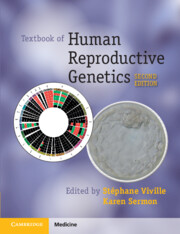Book contents
- Textbook of Human Reproductive Genetics
- Textbook of Human Reproductive Genetics
- Copyright page
- Contents
- Contributors
- Chapter 1 Basic Genetics and Cytogenetics: A Brief Reminder
- Chapter 2 Application of Whole-Genome Technologies to Assisted Reproductive Treatment
- Chapter 3 Meiosis: How to Get a Good Start in Life
- Chapter 4 Chromosomes in Early Human Embryo Development: Incidence of Chromosomal Abnormalities, Underlying Mechanisms, and Consequences for Diagnosis and Development
- Chapter 5 DNA Is Not the Whole Story: Transgenerational Epigenesis and Imprinting
- Chapter 6 Genes Are Not the Whole Story: Retrotransposons as New Determinants of Male Fertility
- Chapter 7 Chromosomal Causes of Infertility
- Chapter 8 Genetics of Human Male Infertility: The Quest for Diagnosis and Treatment
- Chapter 9 Genetics of Human Female Infertility
- Chapter 10 Preconception Genetics Analysis/Screening in IVF
- Chapter 11 Genetic Counseling in Assisted Reproductive Treatment
- Chapter 12 Mitochondrial Genetics in Reproductive Medicine
- Chapter 13 Preimplantation Genetic Testing
- Chapter 14 Epigenetics and Assisted Reproductive Technology
- Chapter 15 Human Reproductive Genetics in Medically Assisted Reproduction: Ethical Considerations
- Index
- References
Chapter 13 - Preimplantation Genetic Testing
Published online by Cambridge University Press: 15 December 2022
- Textbook of Human Reproductive Genetics
- Textbook of Human Reproductive Genetics
- Copyright page
- Contents
- Contributors
- Chapter 1 Basic Genetics and Cytogenetics: A Brief Reminder
- Chapter 2 Application of Whole-Genome Technologies to Assisted Reproductive Treatment
- Chapter 3 Meiosis: How to Get a Good Start in Life
- Chapter 4 Chromosomes in Early Human Embryo Development: Incidence of Chromosomal Abnormalities, Underlying Mechanisms, and Consequences for Diagnosis and Development
- Chapter 5 DNA Is Not the Whole Story: Transgenerational Epigenesis and Imprinting
- Chapter 6 Genes Are Not the Whole Story: Retrotransposons as New Determinants of Male Fertility
- Chapter 7 Chromosomal Causes of Infertility
- Chapter 8 Genetics of Human Male Infertility: The Quest for Diagnosis and Treatment
- Chapter 9 Genetics of Human Female Infertility
- Chapter 10 Preconception Genetics Analysis/Screening in IVF
- Chapter 11 Genetic Counseling in Assisted Reproductive Treatment
- Chapter 12 Mitochondrial Genetics in Reproductive Medicine
- Chapter 13 Preimplantation Genetic Testing
- Chapter 14 Epigenetics and Assisted Reproductive Technology
- Chapter 15 Human Reproductive Genetics in Medically Assisted Reproduction: Ethical Considerations
- Index
- References
Summary
Preimplantation genetic testing (PGT), until recently known as preimplantation genetic diagnosis (PGD), is an early form of prenatal testing for couples at high risk of transmitting a genetic condition to their offspring, either for monogenic disorders (PGT-M) or chromosomal structural rearrangements (PGT-SR). The goal is to test for the specific genetic status in cells biopsied from oocytes/zygotes or embryos obtained in vitro through assisted reproductive technology (ART) and, following analysis, to transfer to the uterus only those embryos identified as genetically suitable relative to the condition under consideration. The selective transfer of unaffected embryos to the uterus for implantation means that PGT minimizes the need to consider the termination of affected pregnancies. This advantage of PGT means that it has become a widely acceptable alternative to conventional prenatal diagnosis. Of course, PGT is not applied without some ethical concerns. In patients with high risk for transmitting specific genetic conditions to their offspring, including serious single gene disorders and chromosomal rearrangements, there is usually little ethical debate. However, the increased availability and emergence of new uses, such as PGT for autosomal dominant late-onset disorders, cancer predisposition syndromes, PGT for histocompatibility (HLA) typing, and mitochondrial DNA (mtDNA) mutations, are associated with greater ethical controversy and important ethical questions (see Chapter 15).
- Type
- Chapter
- Information
- Textbook of Human Reproductive Genetics , pp. 185 - 201Publisher: Cambridge University PressPrint publication year: 2023

